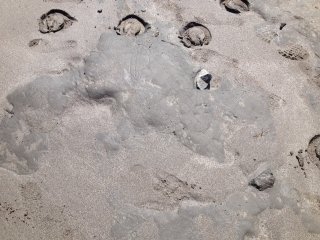 A recent search for a suitable site to go rockpooling on The Lizard peninsula led two Natural England marine staff to Kennack Sands on a sunny blustery day in mid April. One of the first things we noticed was the expanse of exposed clay on the beach, following the offshore movement of much of the sand from the beach during the winter storms; an unusual sight indeed.
A recent search for a suitable site to go rockpooling on The Lizard peninsula led two Natural England marine staff to Kennack Sands on a sunny blustery day in mid April. One of the first things we noticed was the expanse of exposed clay on the beach, following the offshore movement of much of the sand from the beach during the winter storms; an unusual sight indeed.
Photo: Clay at Kennack Sands
After selecting a couple of rocky gullys and overhangs we got busy seeing what we could find, and were shortly rewarded with not one but nine pairs of mating sea lemons during the one hour visit. Sea lemons are sea slugs, a type of mollusc, and are typically found in rocky crevices. They feed on sponges, of which there were also plenty about, and lay gelatinous ribbons on the rock, which contain hundreds of eggs. If you find some of these ribbons on the shore there is likely to be a sea slug lurking nearby somewhere.

Photo: Sea Lemon – Charlotte Marshall
Other mollusc finds included cowries and lots of dog whelks. Dog whelks are predators whose prey includes limpets. By drilling a small hole into the limpet shell, the hungry dog whelk spits digestive enzymes into the limpet, which soften it up enough for the dog whelk to consume.
Strawberry anemones, beadlet anemones, gem anemones and dahlia anemones were also spotted. One of the beadlet anemones we found was in the process of budding. Budding is an asexual method of reproduction adopted by some sea anemones. A new (clone) anemone forms from a bud attached to the parent, separating only when it is mature. We also found some jewel anemones, most commonly found subtidally.

Photo: Budding Beadlet – Charlotte Marshall
The intertidal rocky reef at Kennack Sands extends seawards to create some spectacular diving and snorkelling opportunities. We are fortunate to have many such exceptional reefs around The Lizard including The Manacles Marine Conservation Zone (MCZ) and Lizard Point Site of Community Importance (SCI). SCIs are sites proposed by Member States to the European Commission which, once approved, can be designated as Special Areas of Conservation (SACs). Hopefully we will get an opportunity to return to The Lizard shortly and explore some more rocky shore.
Published: July 2014
Author: Charlotte Marshall Lead Adviser (marine)
